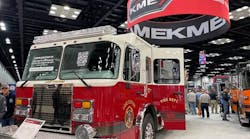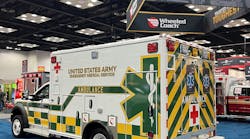The last few installments of "The Apparatus Architect" series covered issues facing the fire service with respect to the impact of the economy on the apparatus industry. During the recently completed Fire Department Safety Officers Association (FDSOA) symposium on fire apparatus, it became clear that budget constraints and shortfalls have hit many departments in the areas of maintenance and fleet replacement.
There are several alternatives to purchasing new units, including rebuilding, glider kits and making improvements in your preventative maintenance program to extend the practical life of your apparatus. Another alternative to the traditional specification and procurement process is to consider acquiring a program fire apparatus for the department.
Most manufacturers produce various models of program pumper apparatus on both commercial and custom chassis. For whatever reasons, some departments have a dim view of these units under the false assumption that they have lost the ability to customize these designs to meet their local needs. First, we must differentiate between a program unit and a stock, or demonstrator, pumper. Many apparatus manufacturers build stock units to have products to show to prospective customers on a demonstration basis or to fulfill immediate needs for customers who may have experienced an accident or other event. These units are typically produced with input from the manufacturers' sales and engineering staffs. For this reason, the completed apparatus generally does not have a lot of "bells and whistles" and, for those departments that heavily customize their rigs, these units have little appeal to this segment of the market.
Program apparatus are designed around a number of pre-engineered options covering all aspects of unit. On a pumper, typical options would include front-bumper equipment, pump-suction and discharge options, foam system and various sizes of water tanks, body styles and numerous compartment equipment designs. Pumper apparatus can be built on both commercial and custom chassis with power ratings between 330 and 425 horsepower with many cab options and seating arrangements.
So what is the advantage of this style of apparatus? From a manufacturer's viewpoint, each of the options and component equipment has been fully engineered to ensure compatibility and to provide some degree of standardization during the manufacturing process. The advantage for the fire department is in cost containment, shorter delivery times and assurance that the apparatus is compliant with all standards.
The South End Fire Company in Winchester, VA, recently placed into service a Pierce Saber pumper that was designed and built using the Contender program. The South End Fire Company is under the command of Chief William Moreland and operates as one of the four fire companies protecting the City of Winchester. The company responds with a combination of career and volunteer staffing and operates two engine companies and an ambulance. In 2008, the station responded to 945 fire incidents with total responses of over 2,500 runs. While the company had purchased full custom engine company apparatus in the past, financial conditions required that it evaluate other options to replace a 1987 pumper.
The result was a 2008 Pierce Contender four-door-cab unit equipped with a 1,250-gpm pump, a 750-gallon water tank and a 40-gallon foam cell with a Husky 12 single-agent foam system. Wagon 5 is built on a short, 172-inch wheelbase with an overall length of 29 feet, six inches. The apparatus was designed to operate within the tight streets of Winchester while maintaining all of the required engine company equipment and appliances. The cab has seating for six personnel and is powered by a 400-hp Cummins ISL engine through an Allison EVS-3000 transmission.
The engine company layout on Wagon 5 is particularly impressive. There are five pre-connected attack lines, including a 100-foot 1¾-inch trash line, two 200-foot 1¾-inch crosslay lines, a 200-foot 2½-inch bomb line attached to an Elkhart monitor and a 400-foot apartment line consisting of 200 feet of 2½-inch hose with a gated wye with 200 feet of 1¾-inch hose. Other hose carried includes 1,000 feet of four-inch supply line and two beds of three-inch hose used to supply sprinkler and standpipe connections.
Chief Moreland emphasized safety on South End's new pumper by specifying an FDNY-style steel-reinforced bumper, LED turn signals mounted low in the front, a backup camera and safety netting for the hosebeds. The engine is also equipped with a gated front suction, 12-volt scene lights and LED warning lights around the unit.
Somewhat unusual is the hydraulic ladder rack installed on the left side of the apparatus. Because of the narrow streets that are found in the Old Town section of Winchester, having the ladder rack on the left side of the pumper allows the driver to position the apparatus to leave room for the ladder company as well as provide adequate room to drop the ladder rack in tight locations.
The South End Fire Company did an excellent job in researching the available technology and safety components while designing a practical engine company unit that not only met its needs, but met its budget while providing a well-thought-out piece of apparatus.
Given the financial constraints that some departments may encounter in the near future, consideration for a program-style engine apparatus may just be the answer to your problem.
TOM SHAND, a Firehouse® contributing editor, is a 33-year veteran of the fire service and works with Michael Wilbur at Emergency Vehicle Response, consulting on a variety of fire apparatus and fire department master-planning issues. He is employed by Seagrave Fire Apparatus LLC as a regional sales manager.
MICHAEL WILBUR, a Firehouse® contributing editor, is a lieutenant in the New York City Fire Department, assigned to Ladder Company 27 in the Bronx, and has served on the FDNY Apparatus Purchasing Committee. He consults on a variety of apparatus-related issues around the country. For further information, access his website at www.emergencyvehicleresponse.com.





